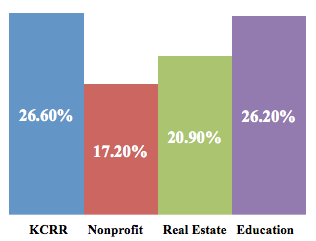Keller Center Research Report - Creating a Competitive Level of Engagement
Andrea Dixon, PhD - Editor, Keller Center Research Report
Bridging current academic research and the real estate practitioner audience, the Keller Center Research Report plays uniquely in the knowledge marketplace. Our Keller Center team identifies cutting-edge rigorous research with interesting implications for the real estate market. We work closely with our authors to ensure that the scholarly work is translated for our audience.  Once the academic research is translated, we work intensely to ensure that each issue of the journal breaks through and captures the attention of you, our reader.
Once the academic research is translated, we work intensely to ensure that each issue of the journal breaks through and captures the attention of you, our reader.
The e-newsletter that announces each issue of the Keller Center Research Report includes eye-catching photos and active links to the journal articles to capture your attention and engage you as a reader. In a world where business people receive “piles” of emails each day, we set a goal to beat the click through rates of industry averages. Using key performance email marketing metrics as a benchmark, we are pleased to report competitive levels of engagement among our Keller Center Research Report readers.
The Comparison: Who
When we compare metrics measuring email activity levels (Silverpop 2013), we see how the Keller Center Research Report compares to the national industry averages. Relevant comparison groups include the real estate industry, education and nonprofit organizations. Benchmarking the Keller Center Research Report against these three targets on key email metrics gives us perspective on how competitive the Keller Center Research Report is when engaging our audience.
The Comparison: What
Two key metrics provide perspective on the target audience’s level of engagement: open rates and click-through rates. Useful for observing trends, the open rates is measured by the number of times an email message is opened. The open rate can be measured as gross or unique. While the gross open rate (which represents the number of times an email is opened either by original recipients or others to whom the email has been forwarded) is an interesting metric, the unique open rate narrow this definition to include just one opened email per one recipient. Thus, the unique open rate tells us how well we are reaching our subscriber audience. Open rates are not the only significant measure of subscriber engagement. In fact, the click through rate measures the percentage of email messages that captured at least one click from a recipient. As a result, the click through rate suggests a level-deeper engagement.
The Competitive Comparison
Compared to industry averages (Nonprofits, Education, and Real Estate), the The Keller Research Report strikes a very competitive position in the areas of unique open rates and click through rates. The Keller Research Report's average unique open rate was 26.6% which exceeds all benchmark industry comparisons. The nonprofit arena’s unique open rate at 17.2% represents the lower end of our benchmarking comparisons while the real estate industry’s unique open rate is a little higher at 20.9%. Coming in closest to the Keller Center Reportis education with the unique open rate of 26.2%. When comparing Keller Center Research Report's unique open rate to these other industry averages, our journal’s newsletter narrowly beats education but outperforms real estate (by 5.7%) and nonprofits (by 9.4%).
Comparison of Unique Open Rates for 2013
(Source: Silverpop 2013 vs. Internal Records)
Open rates are not the only significant measure of subscriber engagement. To ensure that the content from the Keller Center Report impacts our readership’s businesses, we were eager to compare click through rates to these other industries. Since the click through rate measures the percentage of email messages capturing at least one click from a recipient, it is a measure of impact of the content itself.
Compared to industry averages (Nonprofits, Education, and Real Estate), the Keller Center Report strikes a very competitive position in click-through rates. The Keller Center Report's average click-through rates was 7.6% exceeding all industry comparisons. The nonprofit’s click-through rate at 2.0% is again the lowest comparison while the real estate industry’s click-through rate is a little higher at 2.8%. Education fares better than nonprofit or real estate with a click-through rate of 5.8%. When comparing Keller Center Report's click-through rate to the industry averages, our journal’s newsletter bests education (by 1.8%), real estate (by 4.8%) and nonprofits (by 5.6%). Again, as the table below illustrates, the Keller Center Report exceeds national industry averages for nonprofits, education, and real estate.
Comparison of Click-Through Rates for 2013
(Source: Silverpop 2013 vs. Internal Records)
By studying the unique open rates and click through rates for several industries, we see that the Keller Center Report provides our readers with an engaging knowledge environment. Click-through rates are particularly important because they show how well the Keller Center is able to attract viewers and visitors.
. . . . . . . . . . . . . . . . . . .
References
Silverpop (2013) 2013 Email Marketing Metrics Benchmark Study: An Analysis of Messages, IBM Publishing.
. . . . . . . . . . . . . . . . . . .
About the Author
Andrea Dixon, PhD
Frank M. And Floy Smith Holloway Professorship in Marketing, Baylor University
Dr. Andrea Dixon (PhD - Indiana University) has an industrial background in research, planning, and advertising, her research interests embrace behavioral issues related to sales, service, and client satisfaction. Andrea has published in the Journal of Marketing, Harvard Business Review, Organizational Science, Journal of the Academy of Marketing Science, Leadership Quarterly, the Journal of Personal Selling and Sales Management, the Journal of Satisfaction, Dissatisfaction and Complaining Behavior, and several other journals. In 2002, Dixon's research published in the Journal of Marketing was selected as the award-winning research in the sales area. Prior to joining Baylor, Dixon was the Executive Director of the MS-Marketing Program and the Ronald J. Dornoff Teaching Fellow at the University of Cincinnati. She has co-authored the book, Strategic Sales Leadership: BREAKthrough Thinking for BREAKthrough Results , and multiple industry-wide research texts. Dixon serves on three editorial review boards and co-chaired the American Marketing Association's 2007 Winter Educator Conference. While serving as a faculty member at the University of Cincinnati (U.C.) and Indiana University-Bloomington (I.U.), Dr. Dixon taught an array of graduate and undergraduate courses. One of U.C.'s MBA EXCEL Teaching Award winners, Dixon was selected for a national teaching award by Irwin Publishing, as a distinguished professor by Indiana University MBA students, and for a university-wide award by her academic colleagues at I.U. In 2008, she was named the Academy of Marketing Science's Marketing Teacher Award winner. Prior to teaching at U.C., Andrea worked closely with GAMA International as the Senior Director of Product Development and Marketing.

